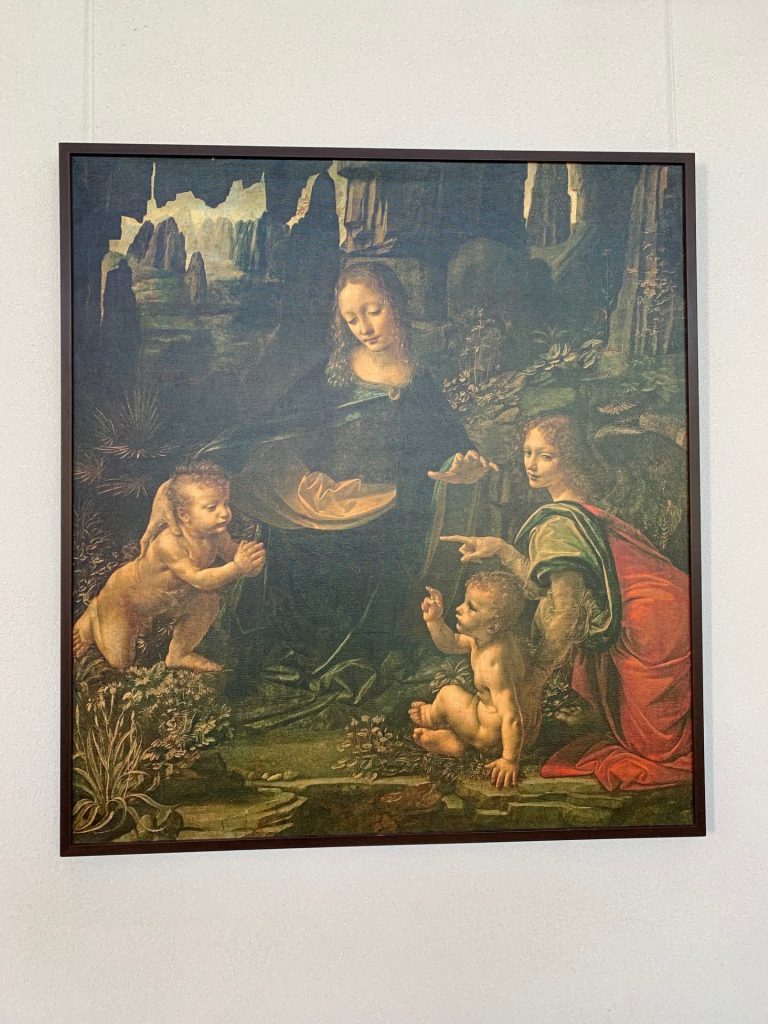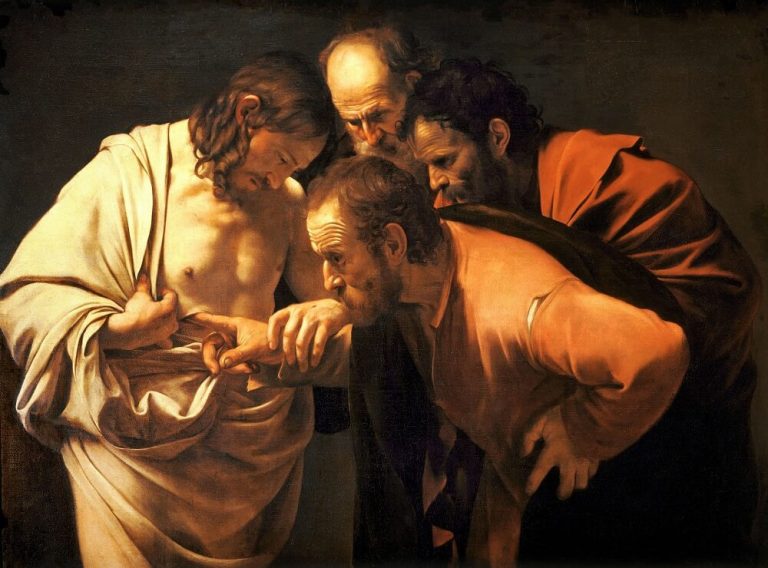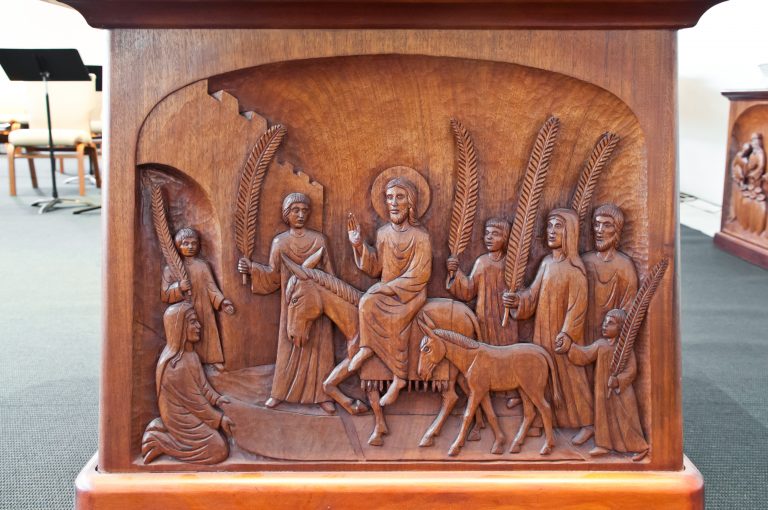Sacred Art
The late John Paul II wrote in his Letter to Artists:
“Art must make perceptible, and as far as possible attractive, the world of the spirit, of the invisible, of God”
So works of art (music included) serves as a bridge between human experience and the divine mystery of God. From the word “human experience” alone, we see so much diversity and people in various stages in their faith walk.
The presence of Sacred art in St. Mark’s chapel serves as both a teaching opportunity, and an opportunity for prayer and reflection. Explore the history and meaning of these works which speak loudly of our Catholic tradition.
Listen to the St. Mark's Parish Choir
Playlist: O God Beyond all Praising, O Sacred Head Surrounded, and Shepherd Me O God.
Paintings
Throughout the Liturgical year, you will observe paintings (reproductions) displayed on the front walls to the right or left of the altar. We will offer some explanation of the meaning and origin of some of these paintings.
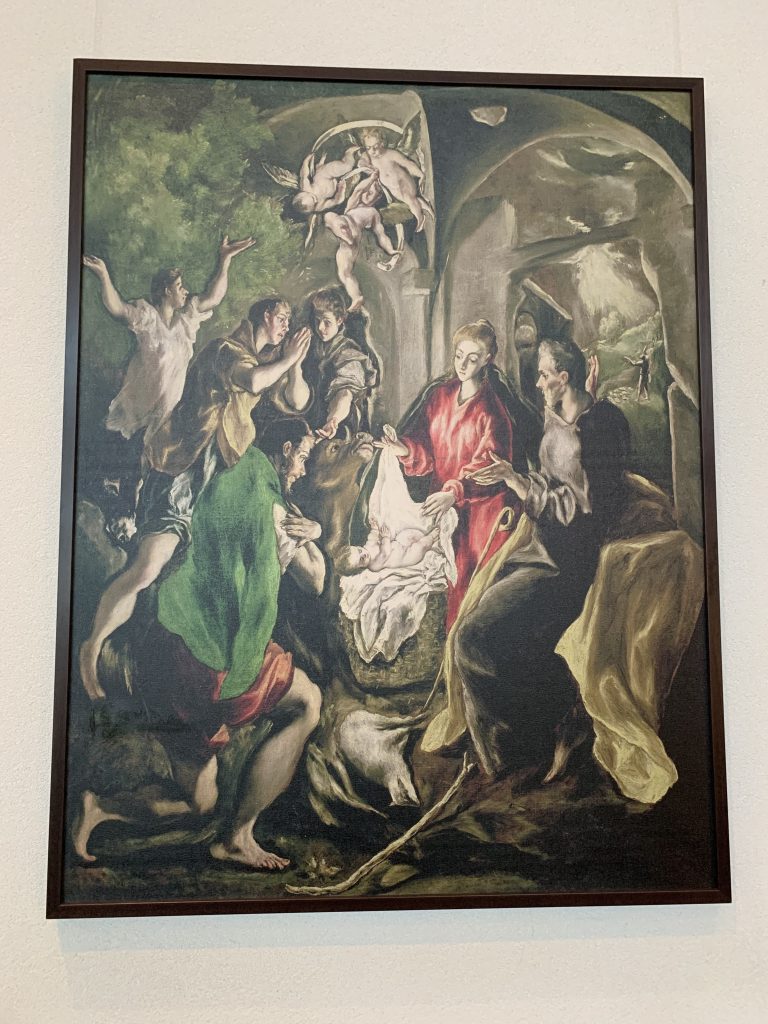
The Adoration of the Shepherds
El Greco (Domenikos Theotokopoulos), 1612-1614.
El Greco completed “The Adoration of the Shepherds” in 1614 before his death, portraying the Nativity scene with distorted shepherds and classical angels. The intentional distortion and vibrant colors aim to evoke ecstatic wonder, highlighting the miraculous birth of Jesus. The painting’s contrast between light and shade intensifies its dramatic effect, while the rhythmic motions of the figures convey a sense of energy. The luminosity emitted by the infant Christ illuminates the shepherds’ faces, while angelic figures add a celestial touch, reminiscent of “The Opening of the Fifth Seal,” completing the scene at Madrid’s Museo del Prado.
The Annunciation
Michelangelo Merisi da Caravaggio, 1608
The angel’s unique portrayal contrasts the Virgin’s calmness, creating a compelling dynamic. The angel’s illusionistic treatment, extending beyond the painting’s space, echoes the Borghese David’s technique, showcasing an advanced ‘Baroque’ style.
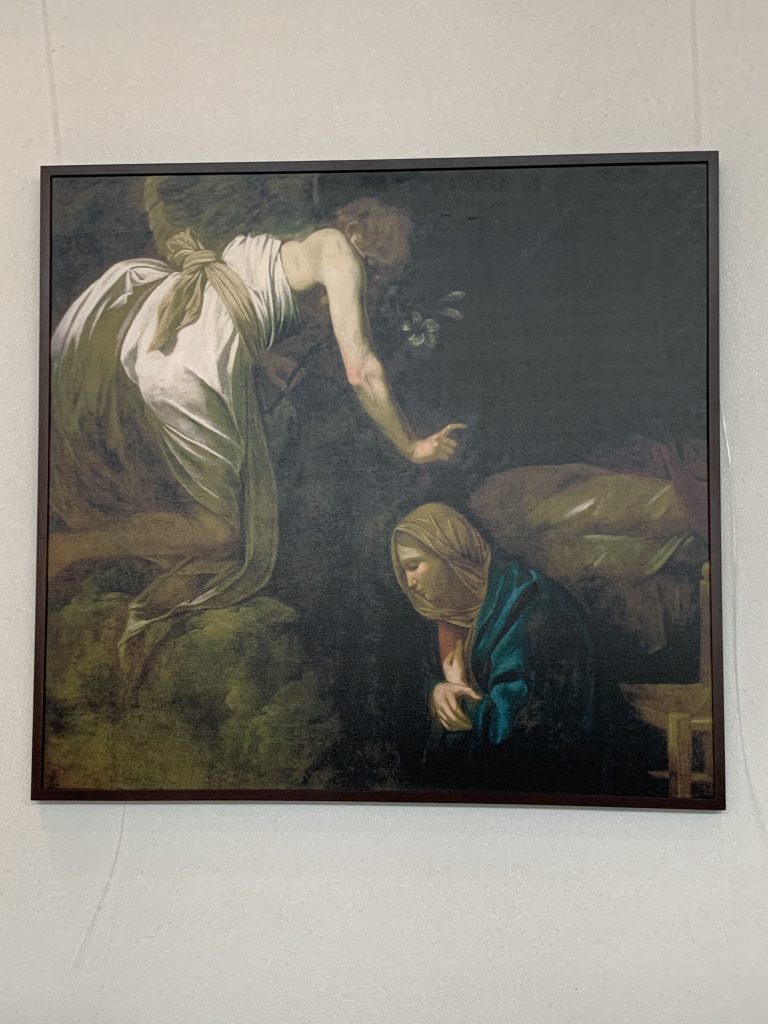
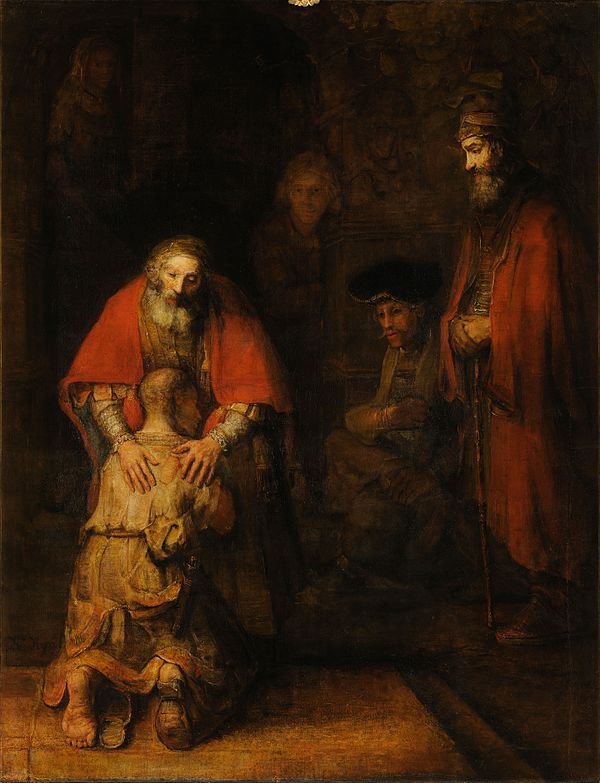
The Return of the Prodigal Son
Rembrandt van Rijn, 1669
“The Return of the Prodigal Son,” one of Rembrandt’s final masterpieces before his death in 1669, portrays the poignant biblical moment of a son’s return to his father after squandering his inheritance.
The painting depicts the son’s destitution and repentance as he kneels before his father, seeking forgiveness and a place back in the family. The father, embracing the son with tender compassion, contrasts with the disapproving older brother standing nearby, symbolizing judgment and resentment.
painting by Leonardo da Vinci, Louvre version (1483–1486); London National Gallery (1508)
The subject of the paintings is a legendary meeting between the infant Jesus and John the Baptist on the flight into Egypt. The Madonna is at the centre of the composition with Jesus seated with the angel Uriel his arm raised in blessing, John’s hands are seen clasped in prayer.
Read more here…
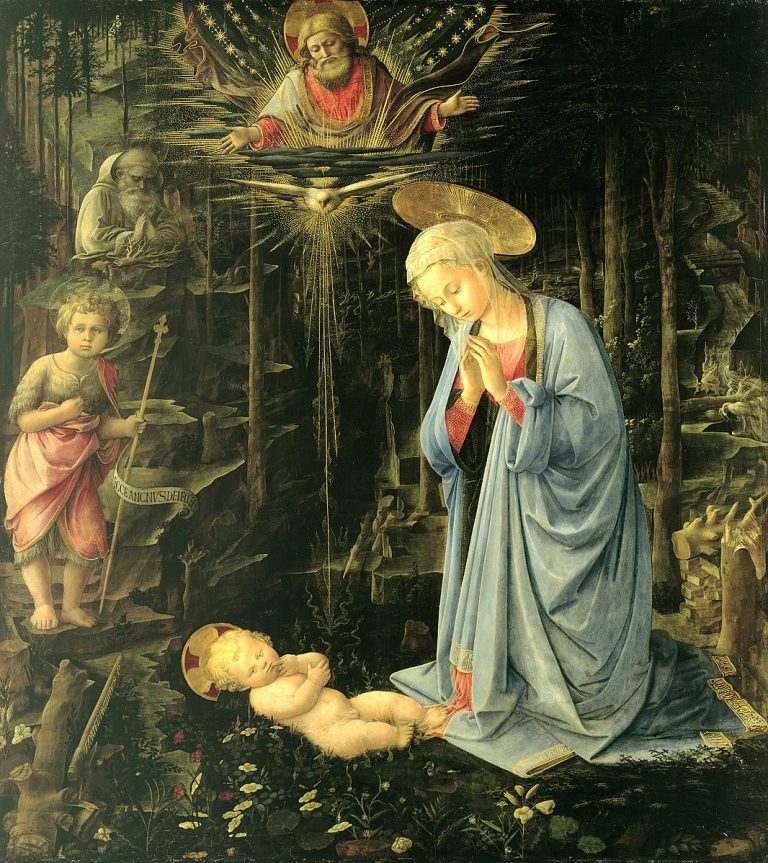
"Mystical Nativity" or "Adoration in the Forest"
by Fra Filippo Lippi (c. 1406 – 1469) around 1459 as the altarpiece for the Magi Chapel in the new Palazzo Medici in Florence
Read more here…
Here are some key points:
Baby Jesus is placed on the ground, and “adored” by his mother Mary
To the left, the infant John the Baptist stands, wearing his attribute of a camelskin coat under a red robe
The praying figure of Saint Romuald appears above John the Baptist.
At the top of the painting, the two other Persons of the Trinity are portrayed (the Father and Holy Spirit)
Descent of the Holy Spirit
by Italian painter Tiziano Vecellio (known as Titian). c. 1545
Read a reflection on this painting and John 14:21-26 here.
Holy Spirit depicted as a dove, descending with its bright light onto the Apostles and Holy Women, as they receive the wisdom of the Holy Spirit – observe the dramatic way this is rendered.
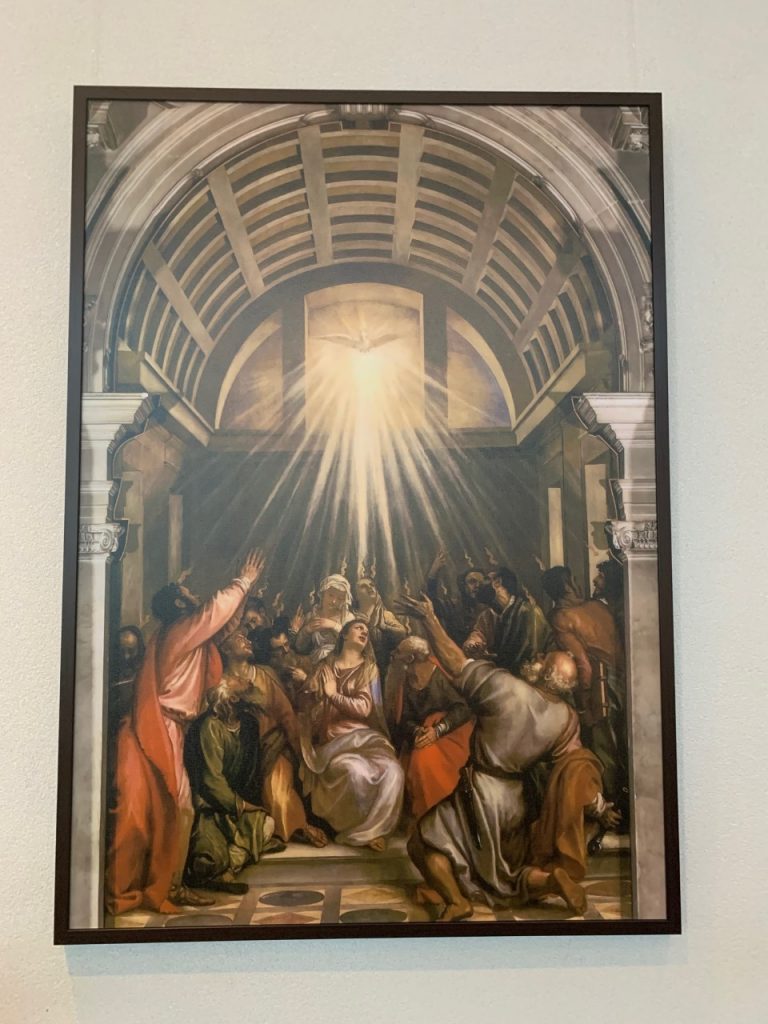
Incredulity of Saint Thomas
by Italian painter Michelangelo Merisi da Caravaggio
John 20:27-29
Then [Jesus] said to Thomas, “Put your finger here; see my hands. Reach out your hand and put it into my side. Stop doubting and believe.”
Thomas said to him, “My Lord and my God!”
Then Jesus told him, “Because you have seen me, you have believed; blessed are those who have not seen and yet have believed.”
More information available on caravalggio,com
Vision after the Sermon
by French artist Paul Gauguin, completed in 1888. It depicts a scene from the Bible in which Jacob wrestles an angel. Genesis 32:22-32
Some key characteristics to note:
– non-naturalistic, abstract, or symbolic portrayal of the scene.
– The painter portrays the watching figures with exaggerated expression and strong contour lines.
– The tree trunk separates the women observing and the angel wrestling with Jacob.
– Is the apple tree, the tree of knowledge from Eden?
More information available on wikipedia, National Galleries Scotland
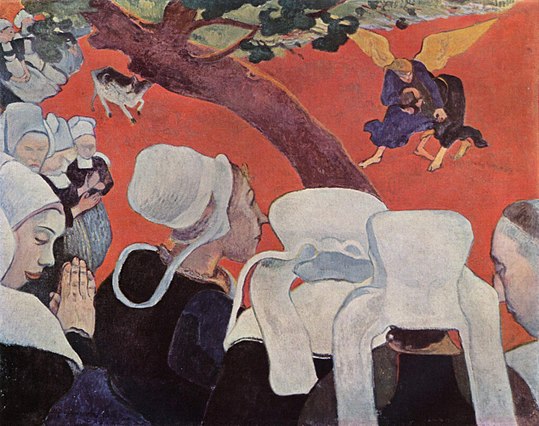
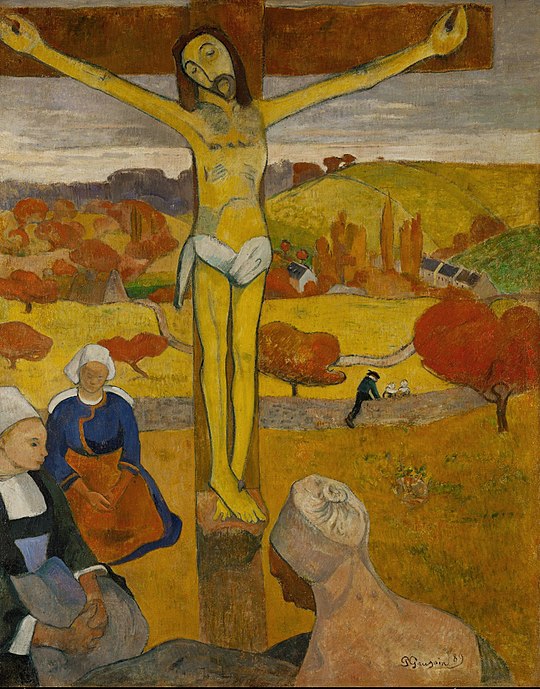
The Yellow Christ (Le Christ jaune)
a painting by Paul Gauguin in 1889 in Pont-Aven
Gauguin based this painting on a seventeenth-century painted wooden crucifix that hangs in the nearby Trémalo Chapel.
The yellow color conveys the piety and isolated life of the peasants, and you can see a few of them kneeling before the cross.
More information available at Buffalo Art Museum, and Wikipedia
The Altar
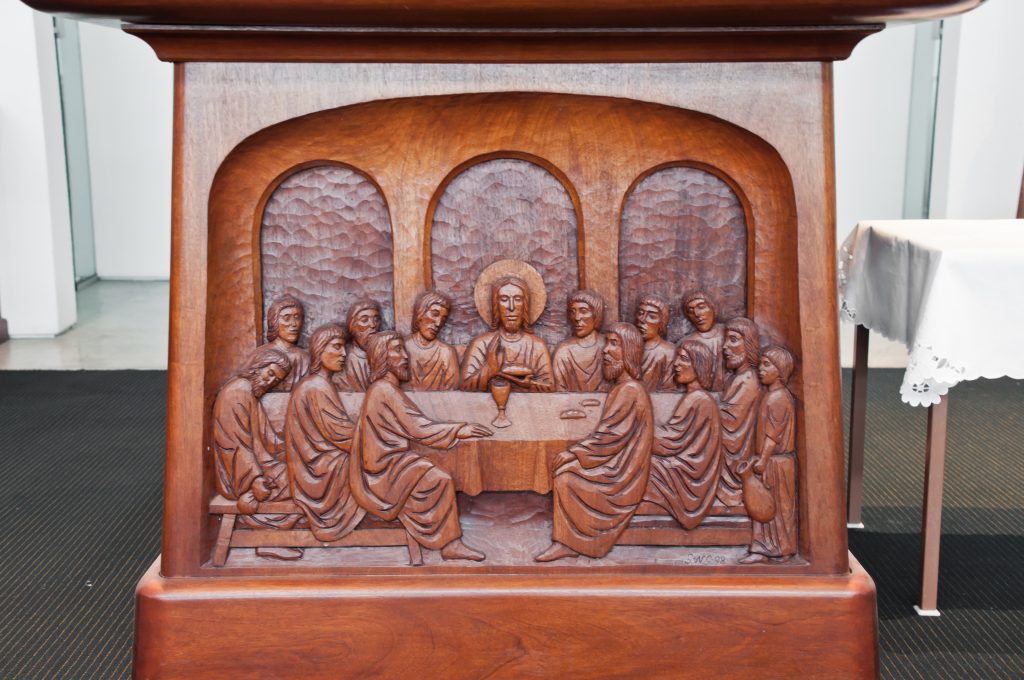
The Last Supper
In this depiction of the Lord’s Supper we are invited to gather with Jesus and his disciples on the night before Jesus would die. Encouraging us to find our place at the table for this Passover meal, the artist has added the image of a servant boy (lower right), carrying the water jar. With this this small detail, the artist invites us to join Jesus and the others that we too might partake in this sacred meal and be filled with graces we need for our particular mission with the Lord.
Jesus is greeted by crowds as he enters Jerusalem.
“Blessed is the king who comes
in the name of the Lord.*
Peace in heaven
and glory in the highest.” (Luke 19, 36-38)
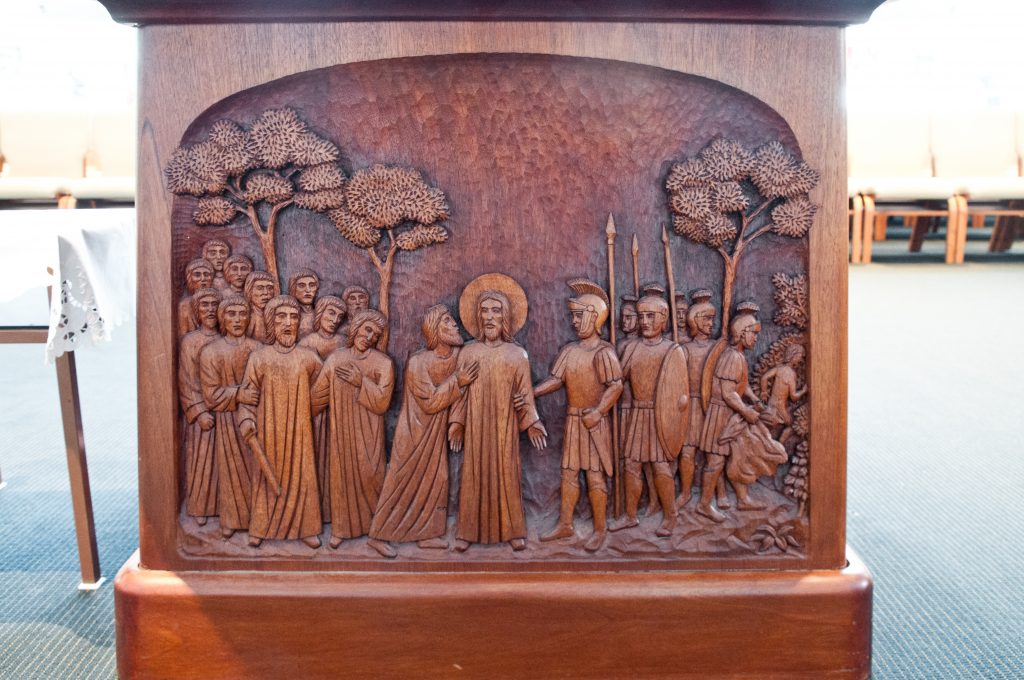
The Son of Man is betrayed with a kiss
Imagine what was going through the mind of Judas himself – having shared an intimate meal with Jesus just hours before. When Jesus predicted his betrayal, why did Judas ask “surely, not I, Lord” (Matthew 26:25)? Was it an admission of his guilt?
How did the other disciples feel at this moment that they discovered that it was their friend whom they have been so closely journeying with Jesus, was their betrayer?
Take a look at this very tense scene, with two soldiers on the right seemingly trying to capture others (followers of Jesus perhaps) who were present at the scene, who are seen fleeing without their cloak.
Credence Table
Jesus visits with Mary and Martha
Observe Jesus’ posture towards Mary as he states “Mary has chosen the better part…”. What does this say about how we make choices in our hectic life, and how we can find Christ during our busy lives?
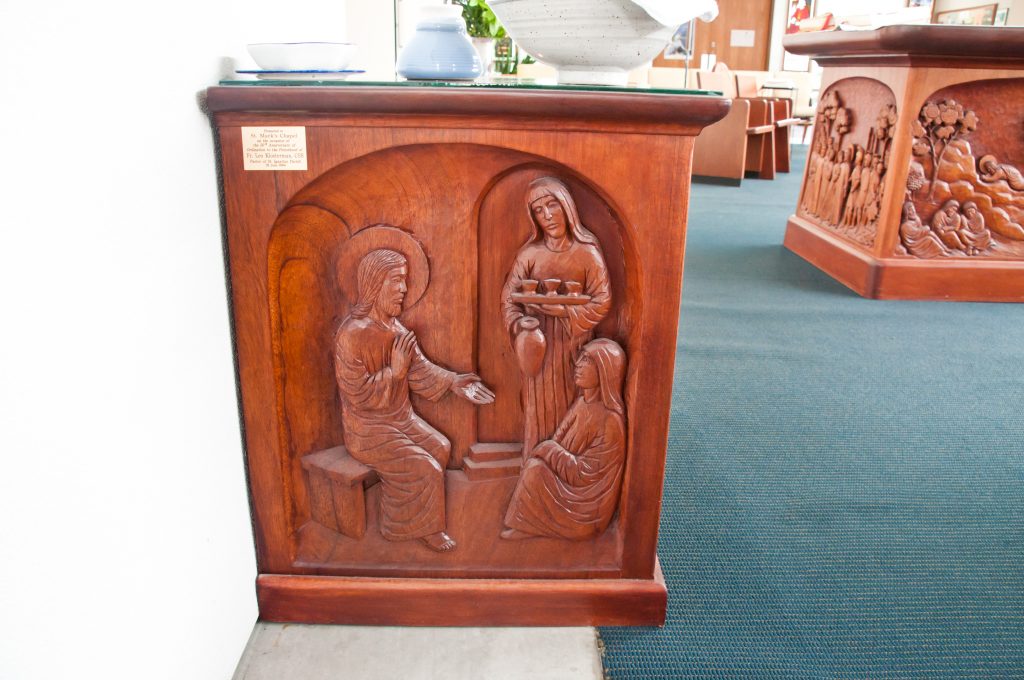
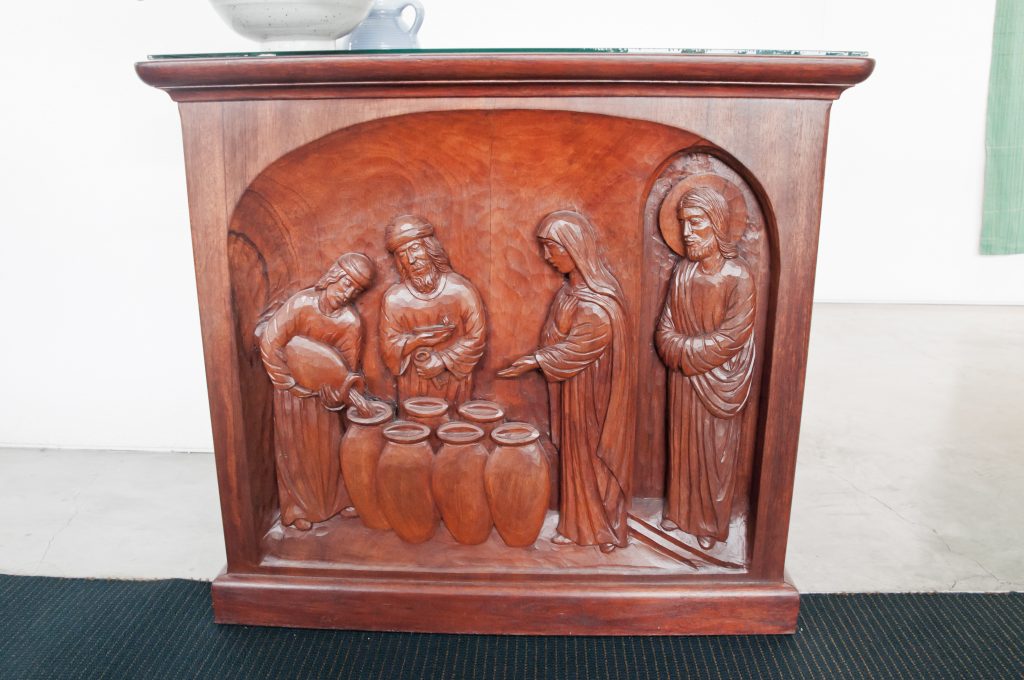
The Wedding at Cana
Mary’s important role is clearly seen here. Her motherly sensitivities saw the need to save the wedding couple from an embarassing situation. Pleading with her son – Jesus answers His mother and immediately fulfills the request.
The Ambo
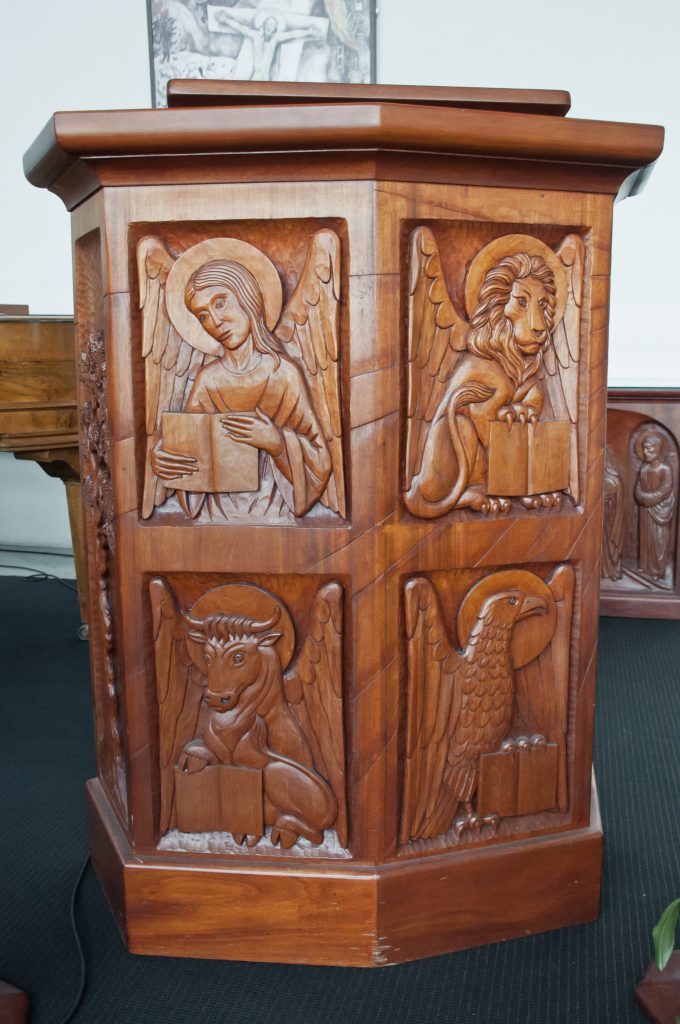
These four figures symbolize the writes of the four Gospels:
Upper left: The winged man (angel): Associated with St. Matthew, as his Gospel is focused on the humanity of Christ.
Upper right: The winged lion: Associated with St. Mark, as his Gospel focuses on the Majesty of Christ
Lower left: The Ox: St. Luke’s Gospel focuses on the sacrificial nature of Christ’s death.
Lower right: The Eagle: St. John, for his foresight.
Proclaim the Word of God when you receive the Holy Spirit
Throughout the old and new Testaments, the Holy Spirit is the agent of God Who prompts us and instructs us to proclaim the Word of God.
But you will receive power when the holy Spirit comes upon you, and you will be my witnesses in Jerusalem, throughout Judea and Samaria, and to the ends of the earth. (Acts 1:8)
To proclaim liberty to the captives, release to the prisoners, To announce a year of favor from the LORD and a day of vindication by our God;
To comfort all who mourn. To place on those who mourn in Zion a diadem instead of ashes,
To give them oil of gladness instead of mourning, a glorious mantle instead of a faint spirit.
(Isaiah 61:1-3)
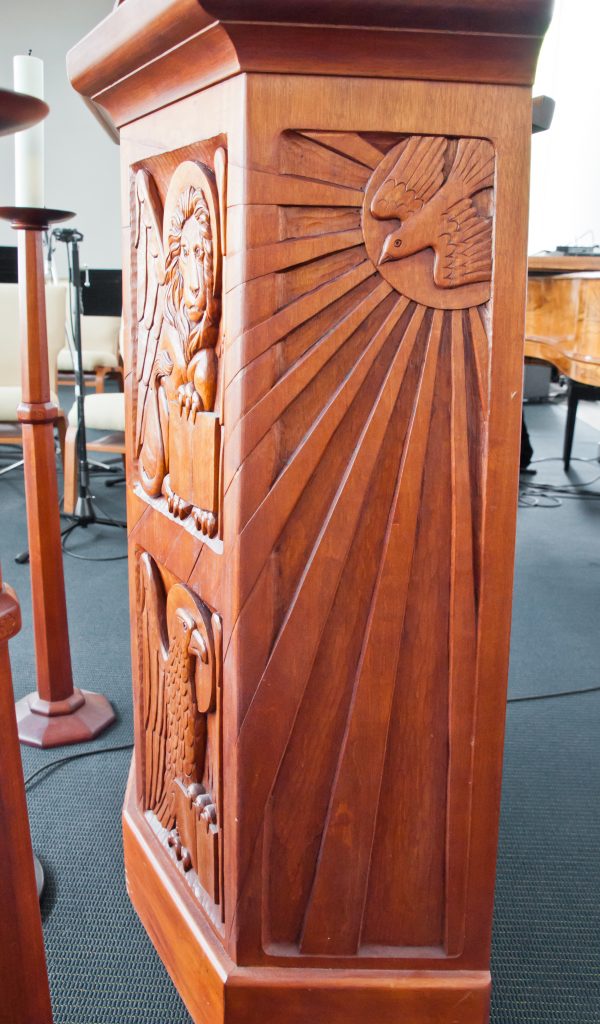
Adoration Chapel
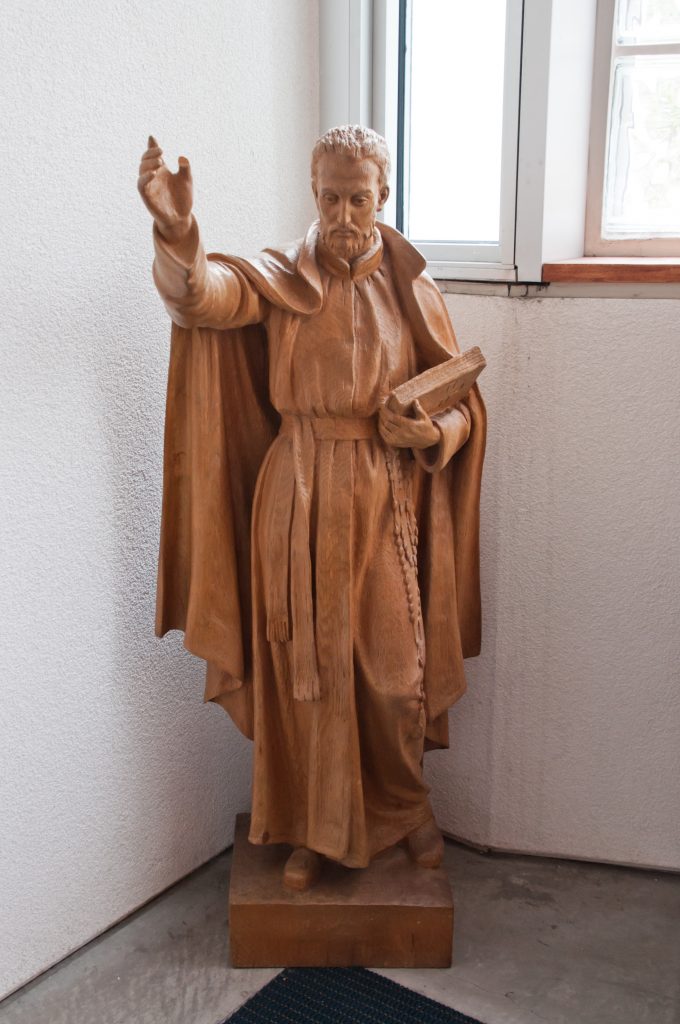
St. John Francis Regis, SJ
This statue resided in the Cenacle house in Vancouver until the Sisters of the Cenacle left Vancouver. This is a gift from Sister Monica Kaufer of the Cenacle Sisters.
Madonna and Child
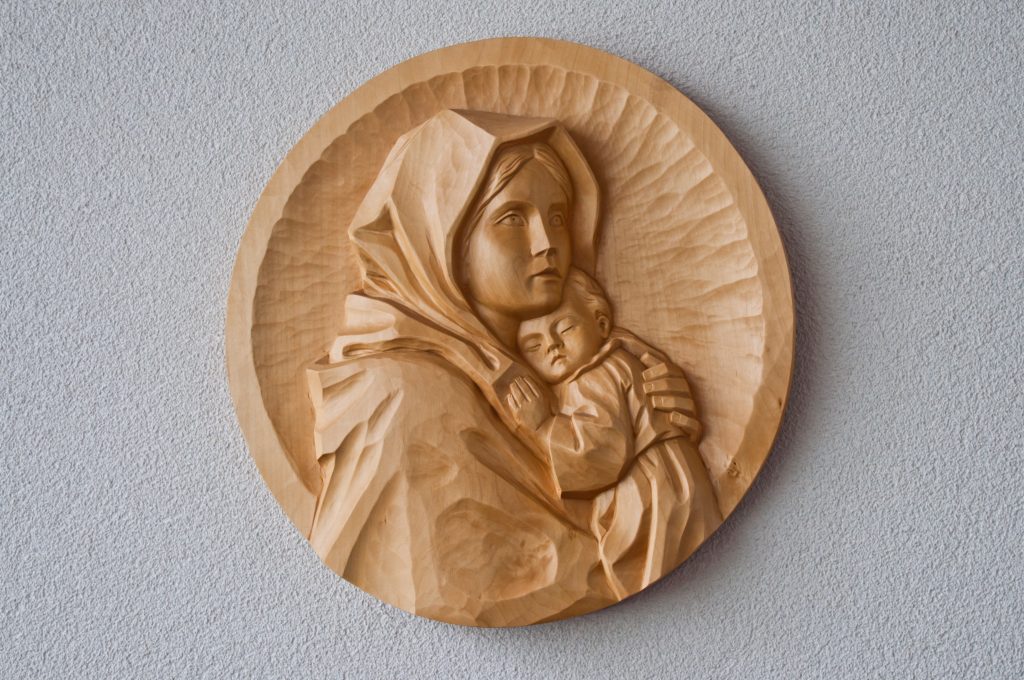
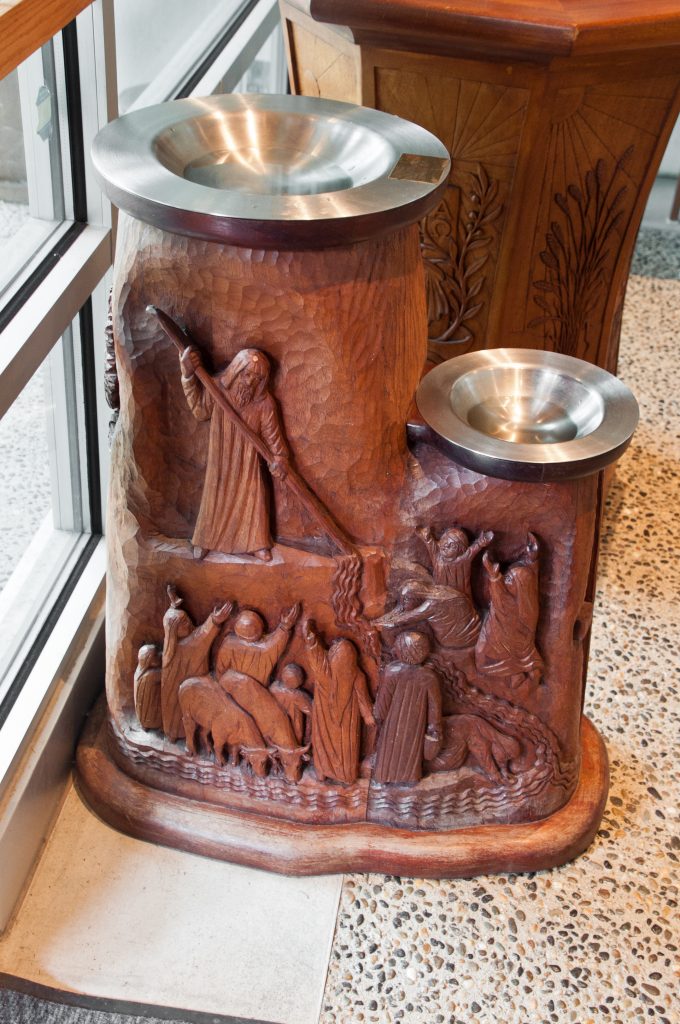
Holy Water Font
Then, raising his hand, Moses struck the rock twice with his staff, and water came out in abundance, and the community and their livestock drank. (Numbers 20:11)
The people of Israel rebeled against their leaders Moses and Aaron because they were led into the desert with no water where they thought they would surely die.
Who would blame them for thinking that? Who would have thought that water could flow from solid rock? Moses and Aaron rebuked them for their lack of faith.
Stained Glass
Saint John Henry Newman
Born in London, England, he spent the first half of his life as an Anglican and the second half in the Catholic Church. He was ordained in the Anglican church in 1824, then converted to Catholicism and was ordained as a priest in 1847.
He especially dedicated himself to spiritually mentoring the students he taught at Oriel college.
He saw many opportunities to revitalize the state of both the Anglican and Catholic churches and sought to build up both institutions by reviving a healthy sense of tradition.
He was canonized by Pope Francis on 13 October 2019, during an open-air Mass in St. Peter’s Square.
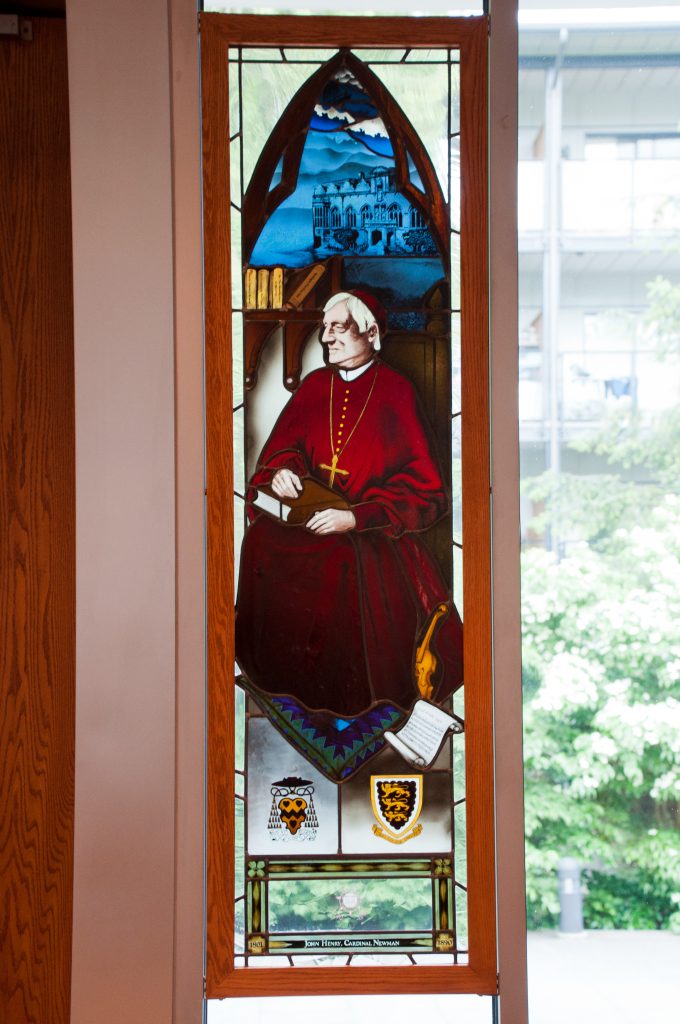
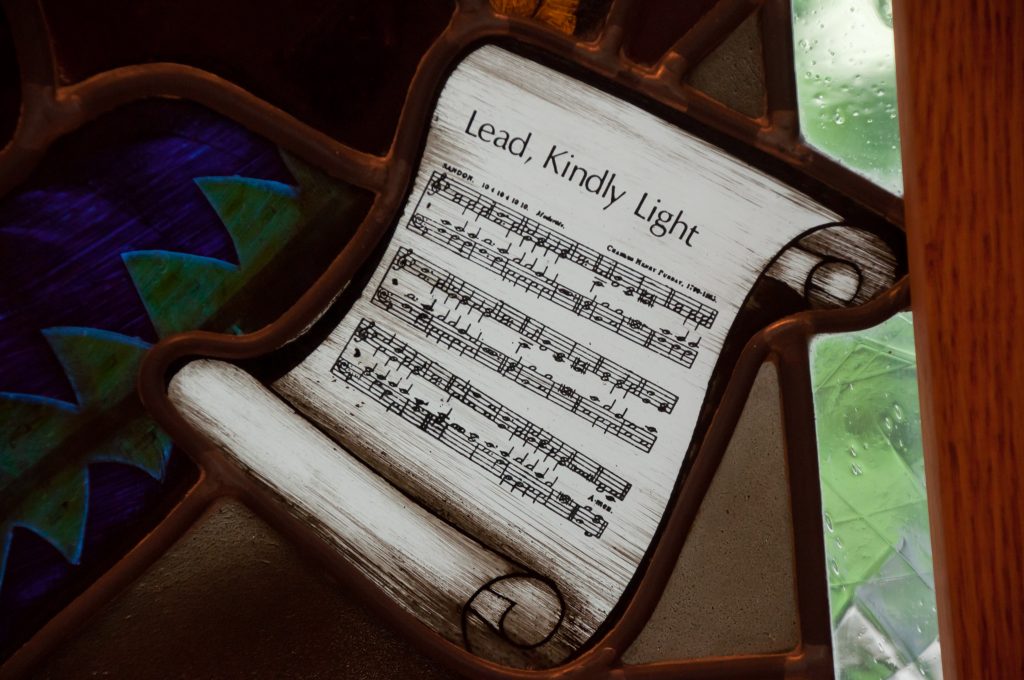
"Lead Kindly Light" - St. John Henry Newman
Lead, Kindly Light, amid the encircling gloom,
Lead Thou me on!
The night is dark, and I am far from home —
Lead Thou me on!
Keep Thou my feet; I do not ask to see
The distant scene, — one step enough for me.
This poem (first stanza is above), originally titled “the Pillar of the Cloud,” was written by John Henry Newman, expressing his prayer to the Holy Spirit during his time of sadness. Pictured in the “scroll”, the poem is most commonly set to the song Sandon by Charles H. Purday.
While on his sickbed, Newman considered his mission in England, despairing at the state of the Church of England at that time.
Listen to the hymn here:
Jesus appears to Mary Magdalene
How did the relationship between Jesus and Mary Magdalene change after His resurrection (when he said “Stop holding on to me…”)? She could no longer see him in the flesh, but rather she would be united in the Mystical body of Christ, the Church which Christ instituted.
In the same way, we Christ call us to encounter Him within the Church, His Mystical Body.
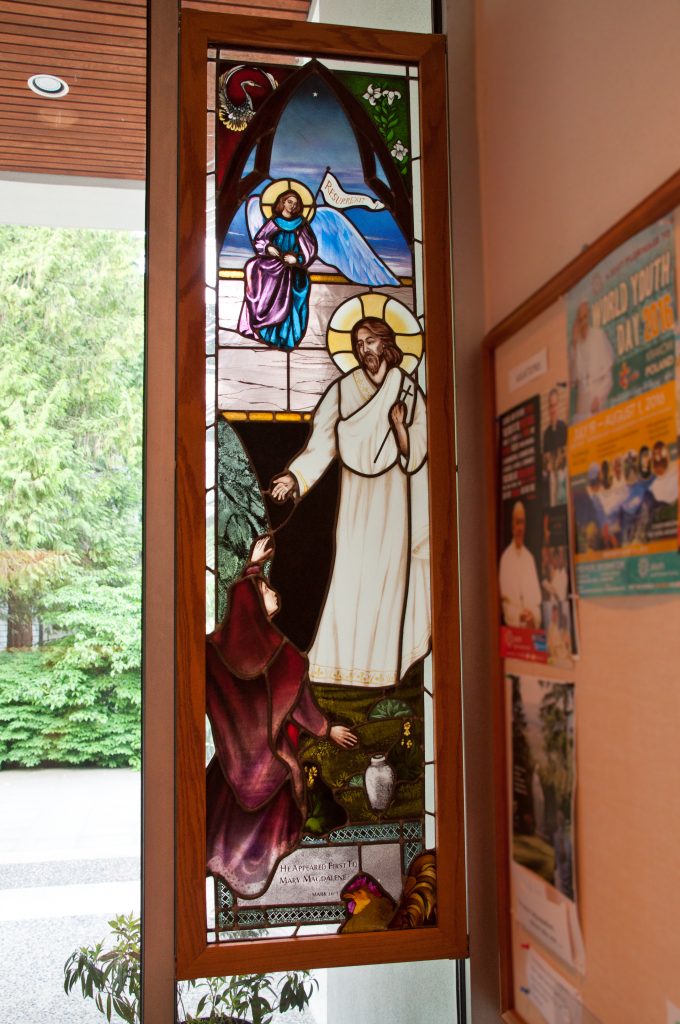
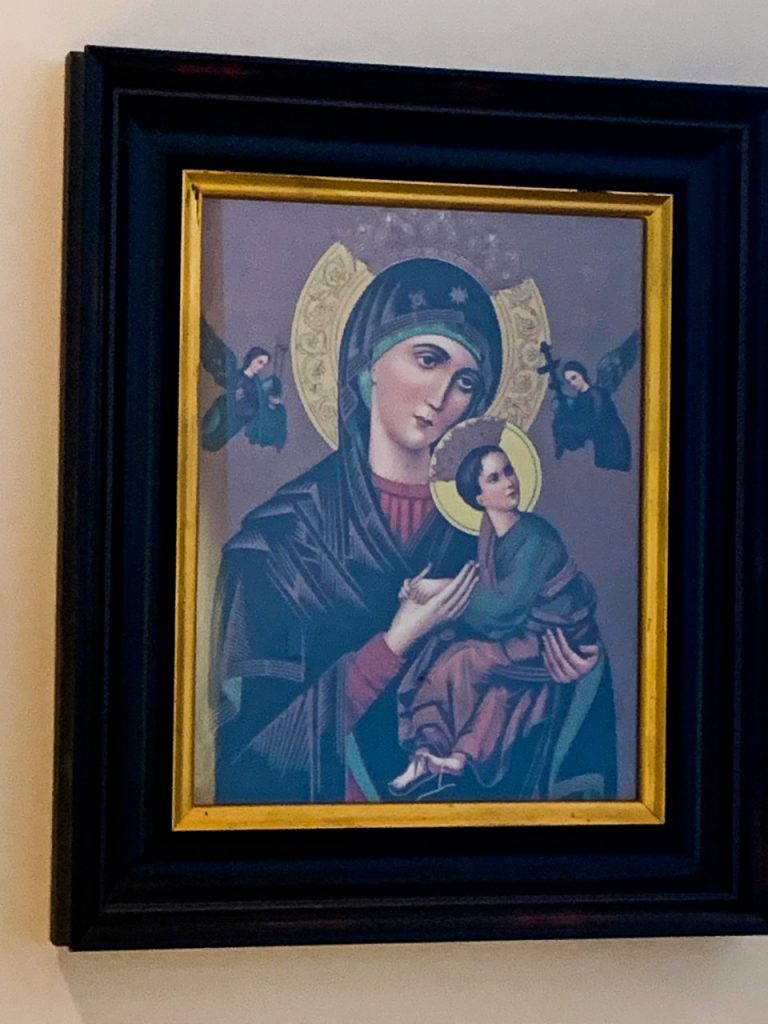
Our Lady of Perpetual Help
A beautiful depiction of Mary, holding her Divine Child, who was frightened by a premonition of His Passion, finds comfort and consolation in her arms.
Stations of the Cross
These stations of the cross, located at the back of the chapel, were sculpted by glass artist James Caesar. Click on the photos to view larger image.
First station: Jesus is Condemned to death
When day broke there was a meeting of the elders of the people, the chief priests and scribes. He was brought before their council, and they said to him, “If you are the Christ, tell us.” He replied, “If I tell you, you will not believe, and if I question you, you will not answer. But from now on, the Son of man will be seated at the right hand of the Power of God.” They all said, “So you are the Son of God then?” He answered, “It is you who say I am.” Then they said, “Why do we need any evidence? We have heard it for ourselves from his own lips.” (Luke 22:66-71)
Second station: Jesus carries the cross
When they saw him, the chief priests and the guards shouted, “Crucify him, crucify him!” Pilate said, “Take him yourselves and crucify him. I find no guilt against him.” … They cried out, “Take him away, take him away! Crucify him!” Pilate said, “Shall I crucify your king?” The chief priests answered, “We have no king except Caesar.” So at that Pilate handed him over to them to be crucified. They then took charge of Jesus, and carrying his own cross he went out to the Place of the Skull, or, as it is called in Hebrew, Golgotha. (John 19: 6, 15-17)
Third station: Jesus falls the first time
Surely he has borne our griefs and carried our sorrows; yet we esteemed him stricken, struck down by God, and afflicted. But he was wounded for our transgressions, he was bruised for our iniquities (Is 53:4-5).
Fourth station: Jesus meets his mother
Fifth station: Simon of Cyrene is made to bear the cross
As they were leading him away they seized on a man, Simon of Cyrene, who was coming in from the country, and made him shoulder the cross and carry it behind Jesus. (Luke 23:26-27)
Sixth station: Veronica wipes the face of Jesus
Seventh station: Jesus falls for the second time
Eighth station: The women weep over Jesus
Large numbers of people followed him, and women too, who mourned and lamented for him. But Jesus turned to them and said, “Daughters of Jerusalem, do not weep for me; weep rather for yourselves and for your children. For look, the days are surely coming when people will say, ‘Blessed are those who are barren, the wombs that have never borne children, the breasts that have never suckled!’ Then they will begin to say to the mountains,“Fall on us!’; to the hills ‘Cover us!’ For if this is what is done to the green wood, what will be done when the wood is dry?” Luke 23: 27-31
Ninth station: Jesus falls for the third time
Tenth station: Jesus is stripped of his garments
Eleventh station: Jesus is nailed to the cross
When they reached the place called The Skull, there they crucified him and the two criminals, one on his right, the other on his left. Jesus said, “Father, forgive them; they do not know what they are doing.” Then they cast lots to share out his clothing. The people stayed there watching. As for the leaders, they jeered at him with the words, “He saved others, let him save himself if he is the Christ of God, the Chosen One.” The soldiers mocked him too, coming up to him, offering him vinegar, and saying, “If you are the king of the Jews, save yourself.” Above him there was an inscription: “This is the King of the Jews”. Luke 23: 33-38
Read the reflection from Pathways to God
Twelveth station: Jesus dies on the cross
Jesus cried out in a loud voice, “Father, into your hands I commend my spirit”; and when he had said this he breathed his last. (Luke 23:46)
Read the reflection from Pathways to God
